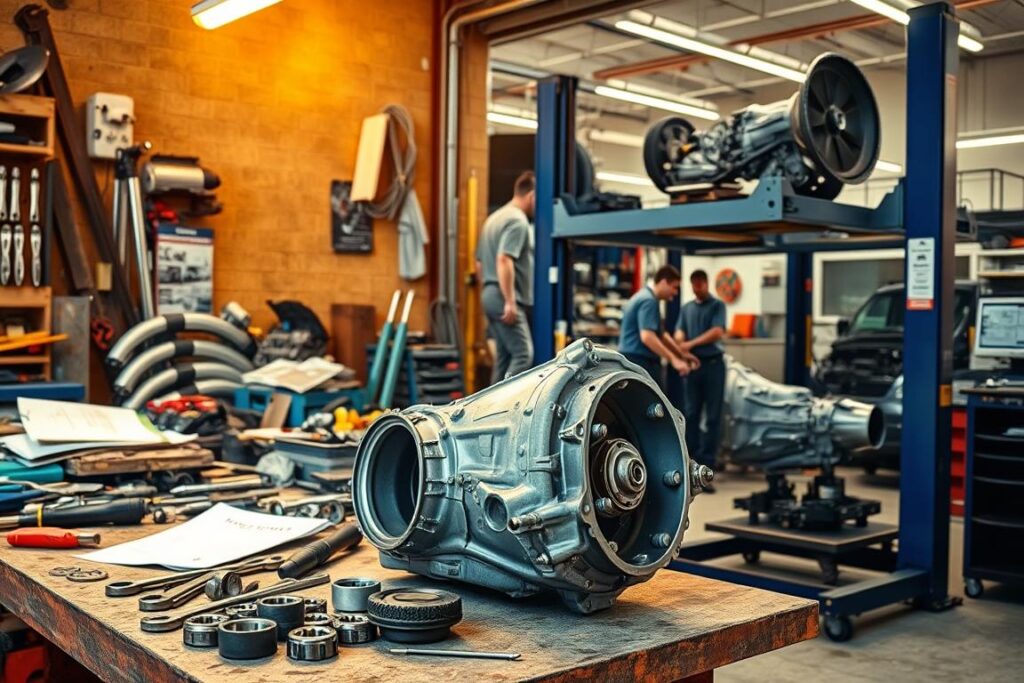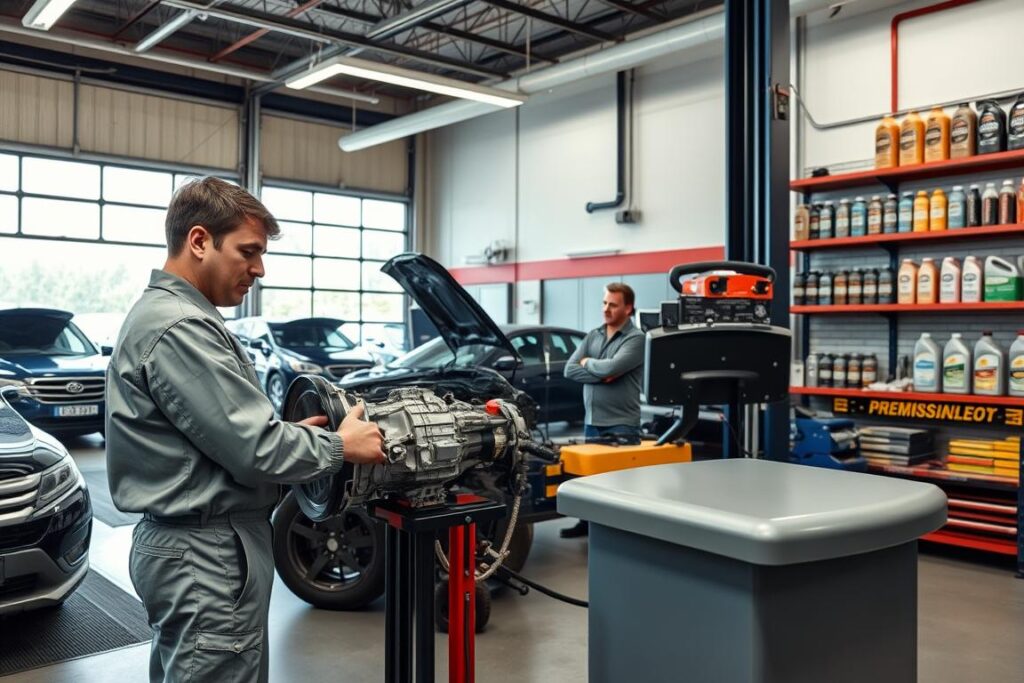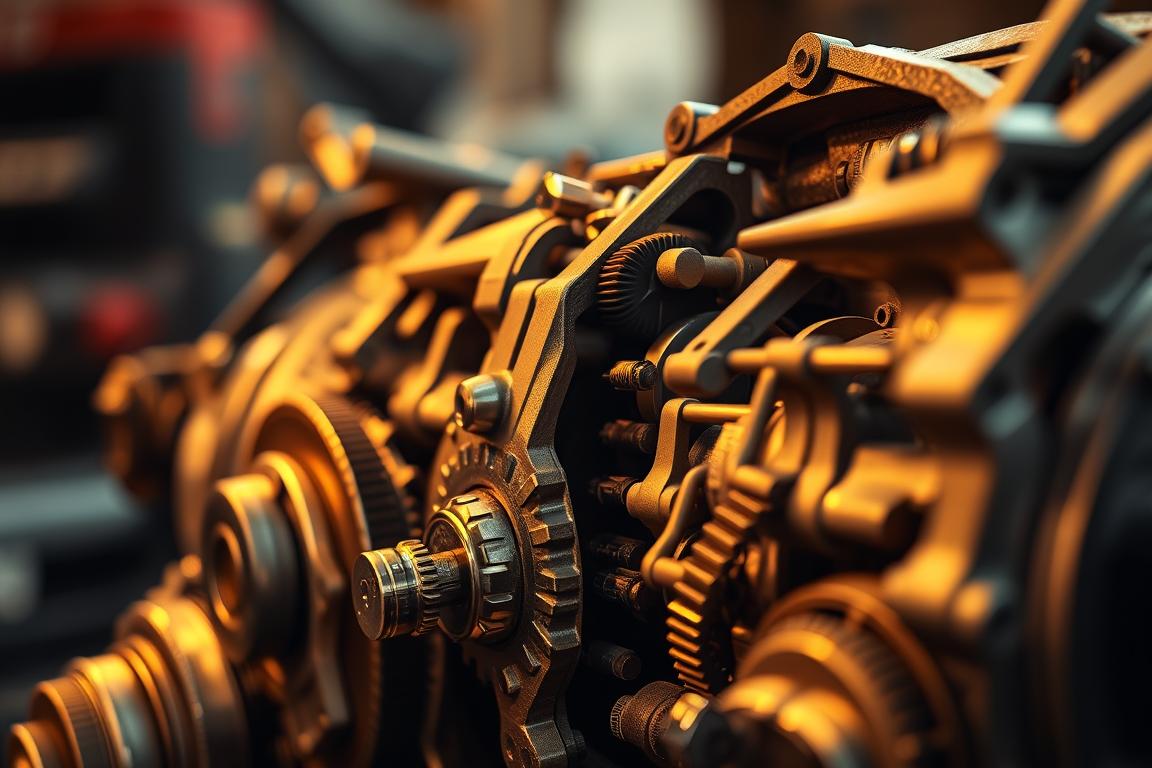Knowing the transmission repair cost is key for car owners. A bad transmission can cost a lot if not fixed quickly.
Transmission problems can be scary, whether you drive a manual or automatic. The cost to fix transmission changes a lot. It depends on your car, how bad the damage is, and the cost of labor.
It’s important to understand what affects the cost of fixing a transmission. This knowledge helps you make better choices for your car’s care.
Key Takeaways
- Transmission repair costs can vary widely depending on the vehicle type and extent of damage.
- Labor costs play a significant role in determining the overall cost.
- Understanding the factors that influence transmission repair costs can help you make informed decisions.
- Regular maintenance can help prevent costly transmission repairs.
- Getting a detailed estimate from a mechanic is crucial before proceeding with repairs.
Understanding Transmission Problems
Transmission problems can be a big worry for car owners. They can show up in many ways, making it hard and expensive to fix if not caught early. These issues can come from wear and tear, not keeping up with maintenance, or even being a factory flaw.
Common Signs of Transmission Failure
Spotting the signs of a failing transmission is key. Look out for slipping or hesitation when shifting gears, odd noises like grinding or whining, and fluid leaks. If you notice any of these, get your car checked by a pro to see how bad it is.
Different Types of Transmission Issues
Transmission troubles can vary a lot, depending on the type and your car’s make and model. Problems can be small, like worn-out parts, or big, needing a whole new transmission. Knowing what’s wrong helps figure out the best fix.
Automatic vs. Manual Transmission Problems
Automatic and manual transmissions face different issues. Automatics might have problems with the torque converter or solenoids. Manual transmissions could have clutch or gear grinding issues. Knowing your car’s transmission type helps you understand its potential problems.
By knowing the signs of transmission trouble and the differences between automatic and manual issues, car owners can act fast. This can help avoid costly repairs and save money in the long run.
What Factors Affect the Cost to Fix Transmission
Transmission repair costs can change a lot. Knowing what affects these costs helps car owners plan for repairs.
Vehicle Make and Model Differences
The car’s make and model matter a lot for repair costs. Luxury cars, like Mercedes-Benz and BMW, have complex transmissions that cost more to fix. This is different from brands like Toyota or Ford.
Transmission Type (Automatic, Manual, CVT)
The type of transmission also plays a big role. Automatics are usually pricier to fix than manuals because they’re more complex. CVTs have their own repair challenges and costs. “Modern automatics are more expensive to repair,” says an auto expert.
Extent of Damage and Age of Vehicle
The damage’s extent greatly affects repair costs. Small issues might just need fluid changes or part swaps. But big problems could mean a full rebuild or replacement. The car’s age also matters, as older cars might have harder-to-find parts.
Parts Availability and Labor Rates
Parts availability can really impact repair costs and time. If parts are rare or come from far away, it can raise costs and wait times. Labor rates vary by location and mechanic skill. Dealerships often charge more for labor than independent shops.
Understanding these factors helps car owners guess repair costs. This way, they can make smart choices about their car’s upkeep and repairs.
Average Transmission Repair Costs Breakdown
Transmission repair costs can vary a lot. It’s important to know the different types of repairs and their prices. Knowing this can help you plan and budget for your car’s needs.
Minor Repairs ($300-$1,500)
Minor repairs fix or replace parts that aren’t badly damaged. These can include fluid changes, solenoid replacements, or adjustments to the transmission linkage. These costs are for less serious issues caught early.
A transmission fluid change can cost $100 to $300, depending on your car and the service. More complex minor repairs, like a solenoid replacement, can cost up to $1,500.
Major Repairs ($1,500-$4,000)
Major repairs are needed for serious damage to the transmission. This includes replacing clutches, bands, or seals in the transmission. These repairs are expensive because they’re complex and take a lot of work.
As
“The cost of major repairs can be a significant financial burden, but addressing the issue promptly can prevent further damage.”
Getting a detailed estimate is key before starting major repairs.
Complete Transmission Rebuild ($2,500-$4,500)
A complete rebuild means taking apart the transmission, checking its parts, and replacing any that are damaged or worn out. This is a detailed and skilled process.
The cost of rebuilding a transmission can be from $2,500 to $4,500. It depends on your car’s make and model, and the quality of the parts used.
Full Transmission Replacement ($4,000-$8,000)
If the transmission can’t be fixed, you might need a new one. This means removing the old one and putting in a new or remanufactured one.
Replacing the transmission can cost a lot, from $4,000 to $8,000. The price changes based on the type of transmission, your car’s make and model, and whether it’s new or remanufactured.
Knowing about these repair types and their costs helps you make better choices. Always talk to a professional mechanic for a correct diagnosis and repair estimate.
DIY vs. Professional Transmission Repair
Transmission problems can be scary, making you wonder if you should fix it yourself or get a pro. Whether to DIY or seek a mechanic depends on the issue, your skills, and tools.
When You Can Fix It Yourself
For small problems like low fluid or a bad solenoid, DIY might work. If you’re good at basic car fixes and have the right tools, you can save money.
When to Seek Professional Help
But, for big issues like internal parts, get a transmission mechanic near you. If you’re not sure or need special tools, a pro is safer and more reliable.

Tools and Skills Required for DIY Repairs
To DIY a transmission fix, you need various tools and know how. Knowing transmission mechanics and repair steps is key.
Safety Considerations for Transmission Work
When fixing transmissions, safety first. Always use jack stands and wear safety gear. If unsure, get professional transmission repair to avoid risks.
| Aspect | DIY Repair | Professional Repair |
|---|---|---|
| Cost | Generally lower, mainly parts cost | Higher, includes labor costs |
| Expertise Required | Basic to advanced mechanical knowledge | Highly specialized knowledge and training |
| Safety | Requires personal safety measures | Professionals are trained for safety |
| Warranty | No warranty on DIY work | Typically comes with a warranty |
In summary, DIY can save money for simple fixes. But for complex issues, professional transmission repair is safer and more reliable.
How to Diagnose Transmission Problems
Figuring out transmission problems can seem tough, but it’s doable with the right steps. A systematic approach helps find the main issue. This can save you time and money later on.
Step1: Identify Warning Signs and Symptoms
The first step is to spot any warning signs or symptoms. Look out for slipping or hesitation between gears, unusual noises, or fluid leaks. Paying attention to these symptoms is key to understanding the problem.
Step2: Check Transmission Fluid Level and Condition
Checking the transmission fluid level and condition is crucial. Low fluid levels or dirty fluid can lead to slipping, hesitation, and odd noises. Make sure the fluid level is right and the fluid is clean.
Step3: Perform a Comprehensive Test Drive
A thorough test drive can show how the transmission works under different conditions. Watch for any slipping or hesitation. Note when these happen.
Step4: Use OBD Scanner for Error Codes
An OBD scanner can give you insights by showing error codes. These codes can point to specific issues, like solenoid problems or sensor failures. They help guide you to the right repairs.
Step5: Document Everything for Your Mechanic
Lastly, document all your findings before seeing a mechanic. Keep a record of symptoms, fluid condition, and error codes. This info helps your mechanic diagnose the issue faster.
By following these steps, you can diagnose transmission problems well. Whether it’s an automatic, manual, or CVT transmission, a detailed diagnosis is the first step to fixing your vehicle.
Finding a Reliable Transmission Repair Shop
Looking for a reliable transmission mechanic near you is easier with a few steps. When your car has transmission problems, finding a trustworthy repair shop is key. This ensures your vehicle gets the best care.
Step1: Research and Read Customer Reviews
Start by looking up potential transmission repair shops in your area. Reading reviews on Yelp or Google can give you insights. Look for mentions of the shop’s professionalism, prices, and how fast they work.
Step2: Ask for Personal Recommendations
Ask friends, family, or coworkers for recommendations. Personal referrals can lead you to a reliable transmission repair shop. They can share their good and bad experiences, helping you decide.
Step3: Check Certifications and Specializations
Make sure the repair shop has the right certifications and specializes in transmission repairs. Look for certifications from the National Institute for Automotive Service Excellence (ASE). A shop that specializes in transmission repairs is more likely to fix your car right.

Step4: Get Multiple Detailed Estimates
Don’t accept the first estimate you get. Instead, ask for detailed estimates from different shops. This lets you compare prices, services, and warranties. Be cautious of very low estimates, as they might hide quality or costs.
Step5: Evaluate Warranty Offerings
A good transmission repair shop should offer a warranty. Look at the warranty each shop offers. A good warranty can give you peace of mind and protect your investment.
| Criteria | Shop A | Shop B | Shop C |
|---|---|---|---|
| Customer Reviews | 4.5/5 | 4.2/5 | 4.8/5 |
| Certifications | ASE Certified | ASE Certified | ASE Certified |
| Warranty Offered | 2 Years/30,000 Miles | 3 Years/50,000 Miles | 5 Years/80,000 Miles |
| Estimate | $1,200 | $1,500 | $1,800 |
By following these steps, you can find a reliable transmission repair shop that fits your needs and budget. Remember, the cheapest option isn’t always the best. Consider the shop’s reputation, expertise, and warranty when deciding.
“A good mechanic is like a good doctor; they diagnose the problem, explain it to you, and fix it with a warranty. Don’t settle for less when it comes to your vehicle’s transmission.”
Questions to Ask Your Transmission Mechanic
To get the best service for your transmission repair, ask your mechanic some key questions. This helps you understand the process, avoid surprise costs, and make sure the work is done right.
About Diagnosis Methods and Results
It’s important to know how your mechanic will diagnose the problem. Ask them about their methods, like OBD scanners or manual checks. Also, find out what they look for during the diagnosis.
About Repair Options and Recommendations
After the diagnosis, ask about the repair options. Understand the differences between repair, rebuild, and replacement. Find out which one is best for your situation.
About Parts Quality and Warranty Coverage
Ask about the parts quality for the repair. Are they OEM or aftermarket? Also, find out about the warranty for the repairs and what it covers.
About Timeline, Loaner Vehicles, and Payment Plans
Knowing the repair timeline is key for planning. Also, ask if they offer loaner vehicles or payment plans to help with costs.
| Question Category | Example Questions |
|---|---|
| Diagnosis | What methods will you use to diagnose my transmission issue? |
| Repair Options | What are my repair options, and which do you recommend? |
| Parts and Warranty | What kind of parts will you use, and what’s covered under warranty? |
| Timeline and Logistics | How long will the repair take, and do you offer loaner vehicles? |
Ways to Save Money on Transmission Repairs
Understanding your options can help lower the cost of transmission repairs. Transmission problems can seem overwhelming. But, there are ways to make repairs more affordable.
Consider Rebuilt or Remanufactured Transmissions
Looking into rebuilt or remanufactured transmissions is a smart move. These are fixed to work like new and often come with warranties. They’re a cheaper option than buying a new one.
Check for Recalls and Extended Warranties
Make sure to check for any recalls or extended warranties on your vehicle. This can save you a lot of money on repairs.
Negotiate Labor Costs and Payment Terms
It’s okay to talk about labor costs with your repair shop. They might offer better payment terms or discounts if you’re paying cash.
Compare Independent Shops vs. Dealerships
Looking at prices from independent shops and dealerships can help you save. Independent shops might charge less for labor. But, make sure they’re reliable and know how to fix transmissions.
Explore Financing Options and Credit Cards
If you can’t pay for repairs right away, look into financing or credit cards. Some shops offer payment plans to help spread out the cost.
Here’s a comparison of the average costs for different transmission repair options:
| Repair Option | Average Cost | Warranty |
|---|---|---|
| Rebuilt Transmission | $1,500 – $3,000 | 1-2 years |
| Remanufactured Transmission | $2,000 – $4,000 | 2-3 years |
| New Transmission | $4,000 – $8,000 | 3-5 years |
By looking into these options and comparing prices, you can cut down on repair costs. Always choose reputable service providers to avoid more problems.

Preventative Maintenance to Avoid Costly Transmission Repairs
Regular maintenance is key to avoiding transmission failures and expensive repairs. By being proactive, you can make your vehicle’s transmission last longer. This way, you can also avoid unexpected breakdowns.
Schedule Regular Fluid Checks and Changes
Transmission fluid is essential for your vehicle’s smooth operation. Regular checks and changes prevent damage and wear. It’s best to check your transmission fluid level every 30,000 to 60,000 miles, or as your vehicle’s manual suggests.
Develop Proper Driving Habits
Your driving habits greatly affect your transmission’s health. Avoid extreme temperatures, sudden acceleration, and riding the brakes. Also, let your vehicle warm up before driving in cold weather to prevent transmission strain.
Maintain Your Cooling System
The cooling system is crucial for your transmission’s health. A faulty cooling system can cause overheating, leading to premature wear and failure. Regularly check your coolant level and ensure your cooling system works well.
Follow Manufacturer’s Recommended Service Intervals
Following your vehicle’s recommended service intervals is vital for transmission maintenance. This includes regular inspections and tasks like fluid changes and filter replacements.
Address Minor Issues Before They Become Major
Ignoring minor transmission issues can lead to bigger problems. If you notice signs like slipping or hesitation, get your vehicle checked by a professional mechanic quickly.
Conclusion
Knowing how much it costs to fix a transmission is key for car owners to avoid surprise bills. The price of fixing a transmission can change a lot. This depends on the type of transmission, the car’s make and model, how bad the damage is, and the cost of labor.
By knowing these things and taking care of your car, you can lower the chance of expensive repairs. Regular maintenance and fixing small problems early can help a lot.
To keep your transmission working well, follow the car maker’s service schedule. Also, check the transmission fluid often and drive right. If you have transmission issues, getting help from a trusted repair shop is smart. This way, you get a fair price for the repair.
Being informed and taking action can save you money on transmission fixes. Looking for affordable repair options helps you choose wisely for your car and wallet.
